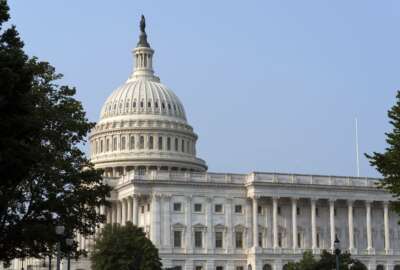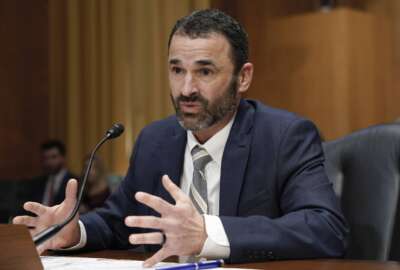Hubbard Radio Washington DC, LLC. All rights reserved. This website is not intended for users located within the European Economic Area.
Pentagon says shutdown wasted at least $600 million
A tally totaling the costs of the government shutdown on the Defense Department only includes lost work-hours from civilian furloughs, not additional government...
wfedstaff | April 17, 2015 5:41 pm
Tallying the total costs of the government shutdown is not a simple task, but in the Defense Department, officials say at least $600 million went to waste.
The dollar figure is a very conservative estimate, but the easiest one to calculate, Defense officials said Thursday. It only reflects the lost productivity in the department as a result of civilian furloughs, even accounting for the fact that during most of the shutdown, the vast majority of that workforce was back on the job.
The shutdown forced DoD to waste funds in myriad other ways, said Robert Hale, DoD’s comptroller, though some of them are more difficult to calculate.
“There were a number of other costs,” he said. “We built up interest payments because we were forced to pay vendors late. We had to fly people back from canceled training classes and then send them right back again.”
DoD officials say they also can’t assign a dollar value on the punishing effects of the shutdown to employee morale, recruiting and retention. And those effects, Hale said, are cumulative.
“It’s not just this event,” he said. “They’ve had three years of pay freezes, we had the sequester furloughs, and now the shutdown furloughs. The folks out in the field are saying, ‘I’m not so sure I want to continue to work for this government.’ We need to keep telling them they’re important, and then we need to show it through pay raises and no more furloughs.”
Hale’s concern about a lack of interest in working for the government was borne out in a survey conducted during the shutdown by the National Treasury Employees Union. 67 percent of federal employees surveyed said they would not recommend a civil service career to their own friends and family.
Concerns about a wave of departures
Colleen Kelley, the union’s president, said the organization will watch for signs of unusually high rates of civil service departures in the coming weeks and months.
“My fear is that we’ll see a lot of employees who are eligible to retire exercising that right because they don’t want to face another shutdown,” she said during a press briefing Thursday in Washington. “Then, with the funding levels under the continuing resolution and sequestration, most agencies are not going to backfill those positions. That’s why the IRS is where they are today. They have 10,000 fewer employees than they did two years ago, and that’s all been just from attrition.”
Kelley said just like in the Pentagon, examples of shutdown-induced waste are abundant in civilian agencies. And unlike in DoD, most employees of those agencies were on furlough for the entire shutdown period.
“If you look at the time preparing for a shutdown, the 16 days of the shutdown, and now the time spent getting everything ramped back up, it’s an immense waste of time for the American people and for federal employees,” she said. “In the mid- 1990s, the Clinton administration estimated the country lost over $400 million just because the IRS enforcement divisions were not doing their work. And that was a four-day shutdown.”
Federal unions say they’re glad that Congress agreed to provide back pay for employees who were furloughed during the shutdown, but they’re worried about the idea that that compensation won’t arrive until their next regularly scheduled paycheck.
Back pay to feds sooner than later?
Agency pay periods vary, but for some workers, the next check is not due for nearly two more weeks. Unions have been urging agencies to issue special accelerated paychecks to cover the shutdown period.
Agencies generally have been receptive to the idea, Kelley said, but none of the agencies in which NTEU workers are represented had yet committed to speed up payments by midday Thursday.
J. David Cox, the president of the American Federation of Government Employees, said only one AFGE-covered agency so far has said it will do so — the Social Security Administration.
“We’re trying to work with all the agencies, but clearly employees were victimized here. They need their paychecks,” he said during a third press briefing of the day about the shutdown. “Many of them will have waited at least a week, but some of them are going to be almost four weeks behind in receiving their pay.”
Back at the Defense Department, officials were quick to point out that while Congress managed to reopen the government, it did not provide agencies with what they’ve been begging for over the course of a couple years now — some level of certainty over their budgets that lasts for more than a few months at a time.
“We’re still kind of plus-or-minus $50 billion for fiscal 2014, and we’re already three weeks into the year,” Hale said. “That’s not a comfortable position for a comptroller. And we have very little flexibility under a continuing resolution. Beyond that, we’ve got to kind of be looking at the fact that eventually we’ll get some kind of appropriation, so we need to be careful on where we spend that money, and we can’t move money between our accounts. So for a while, we kind of have to hold our breath and try to look to the future and be as conservative as we can. If that’s a vague answer, it’s because things are kind of vague. It’s not a good way to run a railroad.”
RIFs remain a possibility
Hale said DoD will slow down its previously planned spending to comply with 2013 budget levels — and probably slightly less than those levels — because sequestration could still reduce the government’s funding even further during fiscal 2014 if Congress doesn’t change it.
It’s not yet clear what that means for the department’s civilian workforce. This week’s agreement to end the shutdown did include a provision letting all agencies move money to payroll accounts from other areas in an effort to head off more furloughs in 2014.
But Hale said if DoD continues to operate under sequestration budget levels, there’s no doubt that the workforce, both military and civilian, will have to shrink.
“Look, if we face budgets at the [Budget Control Act] level, roughly $50 billion less in ’14, we’re going to have to get smaller,” he said. “We will try to avoid reductions in force. We’ll keep them at an absolute minimum. We would look to do this, if we have to, through attrition, but yeah, we’re going to get smaller.”
RELATED STORIES:
DoD to bring back most employees from shutdown furlough
Uncertainty plagues contractors post- shutdown
Short-term debt deal won’t mask big barriers ahead
Copyright © 2024 Federal News Network. All rights reserved. This website is not intended for users located within the European Economic Area.
Jared Serbu
Jared Serbu is deputy editor of Federal News Network and reports on the Defense Department’s contracting, legislative, workforce and IT issues.
Follow @jserbuWFED





